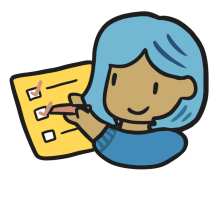Preparing for an oral history interview is important. Preparing in advance will offer opportunities to become familiar with topics relevant to your project, get to know and build trust with a narrator, and to test out your recording equipment. For more in depth information on the preparation, process, and products of oral history see The Three P’s of an Oral History Interview in the sidebar.
Historically, in-person interviews have been the most common approach to oral history. Increasingly, remote interviewing has become a welcomed alternative. There are benefits, advantages, and challenges to both approaches. It is important for both interviewers and narrators to take time to determine which approach is best for them. Factors like: narrator’s preferences, barriers to travel, project deadlines, and technology can inform a decision about which approach in-person, virtual, or a combination of the two is best. For more guidance on considerations for remote interviewing see the Oral History Association's decision tree Considerations for Remote History Interviewing in the sidebar.
Whether planning an in-person or virtual interview, schedule a pre-interview meeting for project participants. In most cases, this type of meeting is for an interviewer and narrator. In some instances, a portion of a pre-interview may also include project organizers and/or a videographer. A pre-interview meeting is an opportunity for narrators and interviewers to meet and to build rapport. At this time, the interviewer and narrator can go over the logistics of the project, consent forms, planned recording, and address questions or concerns. A pre-interview meeting is also an opportunity to test out the recording location and recording equipment. Note that it may not be possible to schedule a separate pre-interview meeting. If this is the case, set aside time at the beginning of your scheduled recording. See Module 4 for more information on this.
During the pre-interview meeting, let the interviewer know what to expect. Let the narrator know:
- Who will be in attendance
- How long the interview will last
- The technology you will use to record
- If recording remotely, any technology the narrator will need
- If recording remotely, offer instruction on how to operate the technology
The pre-interview meeting is a good time to go over a list of questions or topics that you plan to address during the recorded interview. You may choose not to go over the questions one-by-one during the pre-interview meeting. Ideally you will have sent the questions along with consent forms to your narrator ahead of time. For guidance on developing oral history questions see the OC&SEAA Oral History Questions Tip Sheet in the sidebar.
Consent forms, sometimes referred to as release forms, are a vital part of an oral history project. It is imperative that interviewers and narrators understand the intended purpose of the oral history project and how interviews will be stored, preserved, and shared with the public. By signing consent forms, the interviewer and narrator grant project organizers permission to be stewards of the oral history in the ways outlined in the consent forms. See the OC&SEAA Photo Consent Form and OC&SEAA Interview Consent Form in the sidebar for examples of forms used by UCI Libraries.
The pre-interview meeting offers an opportunity to ensure that the narrator has received this information and is given time to ask clarification questions or raise concerns.
During the pre-interview meeting plan to facilitate a sample recording. This will allow you to test the recording technology. Talk about a subject that will not be part of the recorded oral history so your interviewee does not reveal an important story too soon In order to check how the technology like the mic is working. If you are interviewing remotely, test to see if the recording is saved either on your local computer, external drive, or cloud. Also evaluate the environment and atmosphere. Tips on creating a positive atmosphere for an oral history interview are able. The pre-interview can be done in advance and the day of the interview (see Module 4).
Regardless of the recording format you choose for your oral history project, it will be important to consider the environment in which both the interviewer and narrator will record. Ensuring a recording environment that is comfortable for project participants can help foster a positive experience for all. During the pre-recording meeting evaluate the atmosphere and background of the recording location. Factors like noise, foot traffic, lighting (if filming) can impact the quality of the recording. Consider the following:
- Is there background noise?
- Does the location provide privacy?
- Can the interviewer and narrator hear each other?
- For video recordings, is the lighting good?
- For video recordings, is the background appropriate for the interview?
The personal and sometimes sensitive nature of storytelling can stir the emotions of narrators and interviewers. Whenever possible, stage a recording environment that takes these factors into account. Here are a few ideas for ensuring participants wellness:
- Provide or suggest a comfortable place to sit for long periods of time
- Take breaks
- Keep water handy
- Provide or suggest tissues within reach
It may not be possible to achieve certain conditions. The most important thing is to work with your narrator to create a recording environment comfortable for them.
Incorporating objects or props like photographs, maps, scrapbooks, or other materials into oral history recording is one way to help narrators recall their memories or experiences. Prior to recording, ask your narrator to provide a list of the materials they will reference during their interview. If possible, have the narrator bring the materials to a pre-interview meeting so that you can make technical needs or adjustments prior to the official recording date. If an interviewer will provide these objects, the same suggestions apply. The interviewer should provide a list of the items to the narrator and bring these to a pre-interview meeting.
Prior to recording an oral history, decide the technology(ies) you will use. This will entail considering the resources you have at your disposal, any additional resources you will need to obtain, and becoming familiar with how to use your chosen equipment.
In-person interview
Common recording devices for in-person interviews include:
- Mobile devices like cell phones, tablets, and laptops
- Zoom handycam or other recorders specifically designed to capture audio recordings
- Digital cameras
Any of these or other devices can get the job done. Choose the device or devices that will work best for the interviewer, narrator, and intended recording environment. When choosing a recording device, take note of the recording file format. We recommend recording in .mp4 for video or audio and .wav for audio. Also take note of additional accessories needed to record, such as power cords, batteries, SD cards, and camera stands or tripods. Technology can be temperamental and unpredictable. Plan to use more than one device to record. Recording on multiple devices will ensure you have a backup copy of the interview.
Virtual Interviews
There are a number of tools that you can use to record a virtual interview. As with in-person interviewing technology evaluation, choose the tools based on what will fit your needs and skill level.
Potential Tools
- Mobile devices
 Zoom - Recording on the Cloud allows for automated transcription
Zoom - Recording on the Cloud allows for automated transcription YouTube
YouTube
Google Meet
 WebEx
WebEx Instagram Live or other social media recordings
Instagram Live or other social media recordings
These are just a few of the many options available. All come with their own set of pros and cons. A few factors to take into consideration when choosing technology include:
- The recommended file formats are .mp4 for video or audio and .wav for audio
- Some technological tools have limited free versions. In may be advantageous to have a business or Institutional account for full functionality
- Not all recording technologies provide transcriptions. Automated is more efficient than manual transcription
- Explore requirements for backup recordings. For example, if you only have one person conducting the interview, run the audio app on your phone or tablet to capture the audio from the interview. In this scenario, you will want to be in a space that is free of background noise. If you have an interviewer and a tech assistant, one person should save the video recording on the cloud and one person should save the video directly on their computer (local recording).
